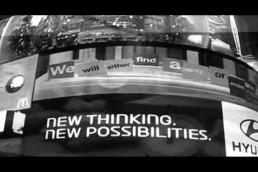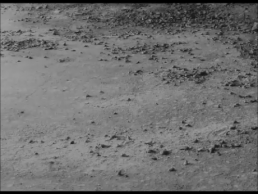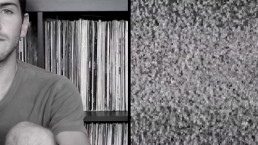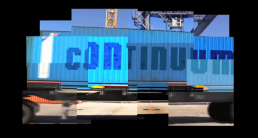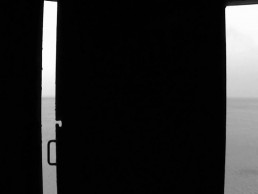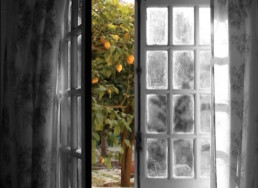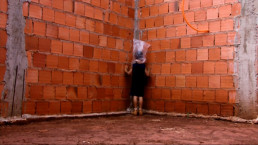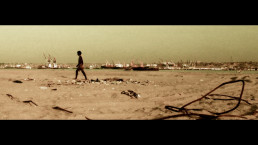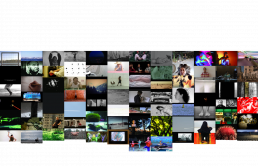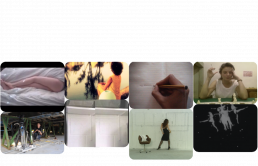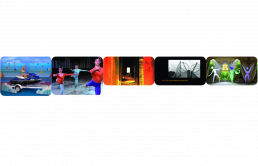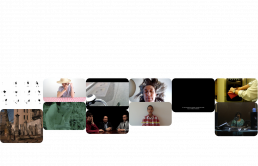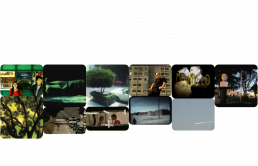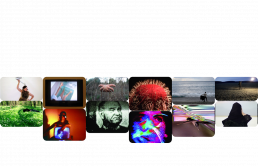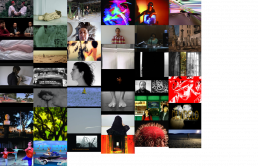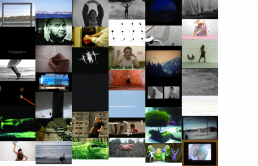“FUSO 2013 – August 20 to September 19“
21 Agosto, 22h
Praça do Carvão, Museu da Eletricidade
Open Call
Seleção de Jacinto Lageira
Plural de cor
Estes últimos anos foram realizados filmes (experimental, ficção, documentário) em preto e branco, cores, que não são geralmente consideradas como tal (um filme ou uma fotografia a cores, um filme ou uma fotografia a preto e branco). Designação paradoxal, já que para nomear essas produções utiliza-se as palavras «preto» e «branco». Outro paradoxo (para além da tecnologia imposta globalmente) prende-se com a realização de poucos vídeos a preto e branco, cores que foram durante bastante tempo a vanguarda desse meio. Solicitamos nesta edição do FUSO obras sobre esta problemática, que pode ser tanto figurativa como abstrata, tanto singular como plural de cor ou de cores. A cor ou as cores como tema principal mas consideradas nessa relação dialética da cor e/ou da não cor.
Jacinto Lageira
João Meirinhos, Agony of a Long Lost Glory, 2013, 11’54’’
A vitalícia dicotomia entre o céu e o inferno, o positivo e o negativo, vida e a morte, os uns e os zeros, o preto ou branco é expresso nesta analogia audiovisual entre a África e a Europa, juntamente com a sincronicidade contraditória de eventos que se sucedem ao mesmo tempo em todo o mundo, os quais, hoje, graças à globalização e à tecnologia, podem ser observados quase imediatamente. Qual será a verdadeira cor da alma humana?
Música original Jack Sheen
Diretor de fotografia Andi Stefo
Conceito e Edição João Meirinhos
Victor Jorge, Landscape, 2012, 2’
Prémio Aquisição EDP
Filme found-footage Super8 de 1979, recuperado e restaurado com uma série de movimentos de câmara panorâmicos, numa paisagem com som/música de Lionel Ritchie, All Night Long.
Victor Jorge & Inês Jacques, Homage, 2013, 1’38’’
Andrea Inocêncio, Wind takes it all, even tears that fall, 2012, 3’01’’
Vídeo, Performance e Edição Andrea Inocêncio
Valter Ventura, 3 fósforos, 2013, 1’41’’
Na linguagem, “ser” e “estar” são termos que se confundem.
As mais remotas questões da filosofia aliam o conhecimento pessoal (“quem sou?”), com a ideia de viagem num espaço (“de onde venho?” e “para onde vou?”).
O nada é assustador. Não conhecemos, não temos palavras para o descrever, não temos imagens para o identificar. É a fronteira do que somos e o limite onde estamos.
3 Fósforos experimenta uma viagem nessa linha de opostos: entre o preto e o branco, o desconhecido e o visível ou entre a escuridão e a luz.
Hugo Segismundo, (Dé)construction de L’installation trouvé, 2012, 4’33’’
A desconstrução de uma imagem através de assunções e aceções dicotómicas. Não se trata de estabelecer parâmetros entre o antes e o depois da cor, o antes e o depois do medium ou o antes e o depois da própria obra, mas sim procurar criar “discursos” que oscilam entre esses mesmos antes e depois. Não apenas no sem cor ou na cor. Não apenas num só meio, mas uma pluralidade do mesmo. Não apenas uma só obra, mas uma multiplicidade da mesma. Uma forma de movimento inerte pensada através da “montagem” e composta por um frame focado sobre diferentes perspetivas. Uma obra de arte total que cita o cinema mudo e reproduz a composição de Cage 4’33’’, englobando assim a própria audiência e acabando por completar a obra.
Autoria e Produção H. Segismundo
Fotografia L’installation Trouvé (2009), impressão P&B, H. Segismundo
João Leitão, senãotetivessecontadoistonãoteriaestacoisa, 2013, 4’29’’
Prémio do Público
A: Às vezes, penso que, se não te tivesse contado isto, não teria esta coisa; que, se não te tivesse contado isto, esta coisa não seria mais do que uma ilusão. Tendo esta coisa, pode-se não a contar a ninguém, instalando-se a dúvida de se ter ou não esta coisa, ou, na melhor das hipóteses, de se ter a certeza de que nunca se teve esta coisa. Mas o facto de te ter contado não é uma ilusão, porque tu sabes e tu não negas que te contei aquilo. E depois, aquilo não é propriamente uma daquelas coisas que se possa contar a alguém sem que realmente não se a tenha.
B: A coisa apareceu-me. Três semanas para resolver a coisa. Entretanto, passaram-se as três semanas e eu nem dei por isso. Por isso, prolonguei a coisa por mais três semanas, ao final das três semanas iniciais. E mais três ao final das seis, e por aí fora. Depois, claro, não consegui deixar de viver em intervalos de três semanas. E já se passaram mais ou menos setenta e cinco intervalos de três semanas, ou seja, duzentas e vinte e cinco semanas.
Conceção, Realização e Montagem João Cristóvão Leitão
Assistência de realização Madalena Fragoso
Performance Miguel Nunes e Sara Leite
Texto (a partir de) David Antunes
Agradecimentos Tiago Jordão
Ana Jesus, Psicocriação, 2013, 1’07’’
Psicocriação é a transferência entre aquilo que é o espólio imaginário do artista e a passagem para uma existência física e material (dita obra artística).
Este vídeo reflete sobre a relação intrínseca entre artista e obra no momento criativo; entre o pensar e o fazer, e o fazer pensando. Essa relação é metaforicamente a trança que liga duas realidades: interior e exterior.
Ana B. & Nuno M. Pereira, Continuum, 2011, 3’01’’
Filmado no porto de Lisboa, o vídeo mostra a captura de diferentes tempos e espaços em movimento contínuo que se sobrepõem num mesmo plano de perceção para criar uma simultaneidade artificial de totalidade da(s) cor(es) gerando uma narrativa visual cinestésica enquanto questiona também a importância da ausência de cor na construção do movimento e da narrativa. Desta forma, o filme desenvolve-se a partir deste aparente paradoxo, mas que vai ao encontra das teorias de Bazin e sobre projeção de luz na escuridão para construção de sentidos, sejam impressões de realidade ou uma desconstrução de um sentido cronológico e linear.
Realização, Argumento e Produção Ana B. e Nuno M. Pereira
Montagem e Mistura de som Nuno M. Pereira
Câmara Ana B.
Susana Mouzinho, Sem título.11, 2011, 6’51’’
Num lugar de fronteira, de limite, ressonâncias afetivas estabelecem-se entre o presente e o passado, entre a ruína e a promessa de um futuro.
Mafalda Relvas, A janela, 2012, 6’26’’
A janela é um filme de contemplação, onde o olhar se prolonga enquanto a janela se revela no tempo. O tom monocromático da janela e a cor da paisagem permitem dar uma nova dimensão à imagem, entre o desenho e a fotografia.
Realização e Montagem Mafalda Relvas
Joacélio Batista, O menino que colhia cascas, 2010, 13’45’’
À beira do rio o menino colhe cascas vazias ante a incerteza da quase tarde, quase noite.
Direção, Fotografia e Edição Joacélio Batista
Banda sonora Catrumanos
Nuno Bouça, Processo cruzado, 2013, 3’17’’
Um homem tomado pela indecisão de partir ou ficar, de agir ou contrair-se, cruza no areal as tensões obscuras na espera do instante que anula o peso da dúvida e de novo se intensifique a vida.
Realização Nuno Bouça
Banda sonora John Cage
August 21, 10pm
Praça do Carvão, Museu da Eletricidade
Open Call
Selection by Jacinto Lageira
Plural of colour
In recent years, some films have been made (experimental, fiction, documentary) in black and white, colour, which are not generally considered as such (a film or a colour photograph, a film or a black and white photograph). A paradoxical designation, since to name these works are used the words “black” and “white”. Another paradox (in addition to the technology imposed globally) is related to the realization of few black and white videos, colours that have been for a long time the forefront of this medium. In this edition, we requested works on this problematic, which can be both figurative and abstract, both singular and plural in colour or colours. Colour or colours as the main theme, but considered in this dialectical relationship of colour and/or colourless.
Jacinto Lageira
João Meirinhos, Agony of a Long Lost Glory, 2013, 11’54’’
The lifelong dichotomy between heaven and hell, positive and negative, life and death, one or zero, black or white is expressed in this audiovisual analogy between Africa and Europe, together with the synchronicity of contradictory events that happen at the same time all over the world and which now, due to globalization and technology, can be observed almost immediately by anyone. Which is the true color of our human soul?
Original soundtrack Jack Sheen
Director of Photography Andi Stefo
Directing and Editing João Meirinhos
Victor Jorge, Landscape, 2012, 2’
EDP Acquisition Award
Victor Jorge & Inês Jacques, Homage, 2013, 1’38’’
Andrea Inocêncio, Wind takes it all, even tears that fall, 2012, 3’01’’
Video, Performance and Editing Andrea Inocêncio
Valter Ventura, 3 fósforos (3 matches), 2013, 1’41’’
In language, “being” (person) and “being” (place) are confusing terms.
One of the most remote philosophical questions combine personal knowledge (“Who am I?”), with the idea of space traveling (“where do I come from?” and “where am I going?”).
The void is scary. We do not know it, we do not have words to describe it, we do not have pictures to identify it. It is the frontier of what we are and the border of where we are.
3 matches undergoes to a journey through that line of opposites: between black and white, unknown and visible or between darkness and light.
Hugo Segismundo, (Dé)construction de L’installation trouvé, 2012, 4’33’’
The deconstruction of an image through dichotomic assumptions and meanings. It’s not about setting parameters between the before and after of colour, the before or after of a medium or even the before and after of the work itself, but rather to create “discourses” which oscillate between those before and afters. Not only in colour or in colourless. Not only in one medium but in a plurality of itself. Not only one work but a multiplicity of itself. A kind of inert movement, thought by its “editing”, composed with one frame focused by different perspectives. A total work of art which quotes the silent films and reproduces Cage’s composition 4’33’’ therefore incorporating the audience and thereby completing the work.
Authorship and Production H. Segismundo
Photography L’installation Trouvé (2009), B&W print, H. Segismundo
João Leitão, senãotetivessecontadoistonãoteriaestacoisa, 2013, 4’29’’
Audience Award
A: Sometimes I think that if I hadn’t told you this, I wouldn’t have this thing; that if I hadn’t told you this, this thing would be nothing else but an illusion. Having this thing, you may not tell it to anyone, creating the doubt of having or not having this thing, or, at best, being sure that you never even had this thing. But the fact that I told you isn’t an illusion, because you know and you don’t deny that I told you that. And then, that isn’t exactly one of those things that you can tell someone without actually having it.
B: The thing appeared to me. Three weeks to solve the thing. In the meantime, the three weeks passed and I didn’t even notice. Thus, I extended the thing for three more weeks, at the end of the three initial weeks. And three more at the end of the six and so forth. Of course, from then on, I couldn’t stop living in three-week periods. And seventy-five three-week periods have already passed, that is, two hundred and twenty-five weeks.
Concept, Directing and Editing João Cristóvão Leitão
Director’s assistance Madalena Fragoso
Performance Miguel Nunes e Sara Leite
Text (based on) David Antunes
Acknowledgements Tiago Jordão
Ana Jesus, Psicocriação, 2013, 1’07’’
Psicocriação is the transference between what is the artist’s imaginary collective and the transition to a physical and material existence (meaning the artwork itself).
This video reflects on the intrinsic relation between artist and artwork in the creative process; between thinking and doing, and doing thinking. This relationship is metaphorically the link which connects two realities: inner and outer.
Ana B. & Nuno M. Pereira, Continuum, 2011, 3’01’’
Shot at the port of Lisbon, this video captures different times and spaces in a continuous movement which overlaps in the same visual field in order to create an artificial simultaneity of a totality of colour(s), while creating a kinaesthetic visual narrative as it questions the absence of colour as an important factor to construct a movement and a narrative. Thus, the film evolves after this apparent paradox, but it actually follows Bazin’s theories on the light projection into the darkness to form meanings, being them impressions of reality or a deconstruction of a chronological and linear sense.
Directing, Script and Production Ana B. and Nuno M. Pereira
Editing and Sound mixing Nuno M. Pereira
Camera Ana B.
Susana Mouzinho, Sem título.11, 2011, 6’51’’
At a frontier, a borderland, affective resonances are established between past and present, between ruin and the promise of a future.
Mafalda Relvas, A janela (The window), 2012, 6’26’’
The window is a video of contemplation, where the gaze lingers as the window reveals itself in time. The monochromatic tone of the window and the colour of the landscape give a new dimension to the image, between drawing and photography.
Directing and Editing Mafalda Relvas
Joacélio Batista, O menino que colhia cascas, 2010, 13’45’’
At the riverside, a boy picks up empty crusts before the uncertainty of the late afternoon, almost night.
Directing, Image and Editing Joacélio Batista
Soundtrack Catrumanos
Nuno Bouça, Processo cruzado, 2013, 3’17’’
A man taken by the indecision of leaving or staying, of acting or contracting, crosses in the sand the dark tensions by the waiting for the moment which will repeal the weight of doubt and once again be able to intensify life itself.
Directing Nuno Bouça
Soundtrack John Cage
